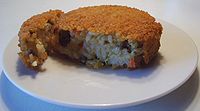 | |
| Course | Snack |
|---|---|
| Place of origin | Netherlands |
| Region or state | Northwestern Europe |
| Created by | Chinese Indonesian cuisine |
| Main ingredients | noodles |
| Variations | Croquette |
A bamischijf Dutch pronunciation: [ˈbaːmisxɛif] is a Dutch snack consisting of a slice (Dutch: schijf) of bami, breaded and deep-fried.[1] It is a Dutch modification of a Chinese-Indonesian noodle dish bakmi goreng.[2] Nasischijf is a similar dish made with nasi goreng.
Preparation[edit]
The filling is prepared using a base of cooked bami. The ingredients are similar to those for bami goreng: vegetables and meat, with Indonesian spices and sauces. The noodles are packed as thick as possible so that the product's filling becomes dough-like in consistency. This mass is formed into a sausage roll, from which slices are cut. These slices are breaded and fried.
Much of this snack's production takes place in factories, where the product is prepared and then frozen, before being shipped to snackbars.
Variations[edit]
Other varieties of bamischijf are usually named after their shape: bamiblok (bami block), bamibal (bami ball) and bamihap (bami bite). Another variation is the nasischijf (nasi slice), which consists of nasi rather than bami.
-
Nasischijf
-
Nasischijf and bamihap, frozen
See also[edit]
References[edit]
- ^ "Bami Schijf". National Post. March 6, 2013. Archived from the original on 14 October 2013. Retrieved 13 October 2013.
- ^ Arrisje (Jul 8, 2012). "Bami Schijf (Dutch)". Kinfolk Recipes. Retrieved 27 August 2015.


Well, that’s interesting to know that Psilotum nudum are known as whisk ferns. Psilotum nudum is the commoner species of the two. While the P. flaccidum is a rare species and is found in the tropical islands. Both the species are usually epiphytic in habit and grow upon tree ferns. These species may also be terrestrial and grow in humus or in the crevices of the rocks.
View the detailed Guide of Psilotum nudum: Detailed Study Of Psilotum Nudum (Whisk Fern), Classification, Anatomy, Reproduction